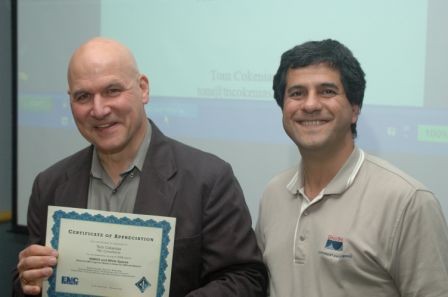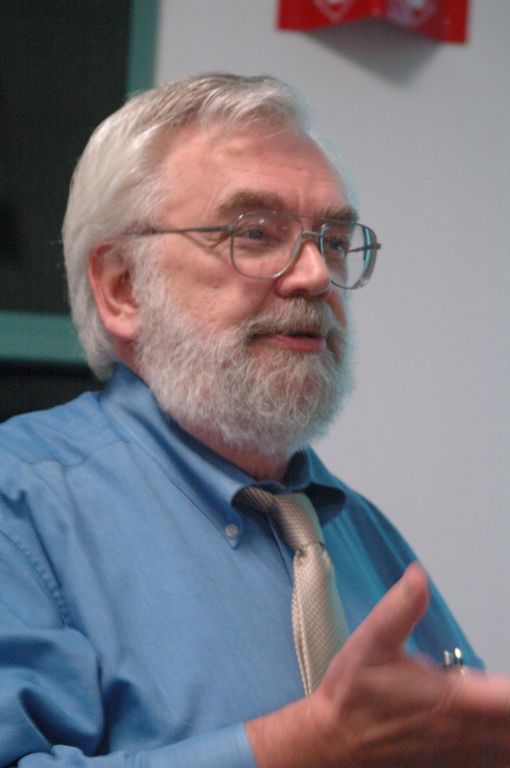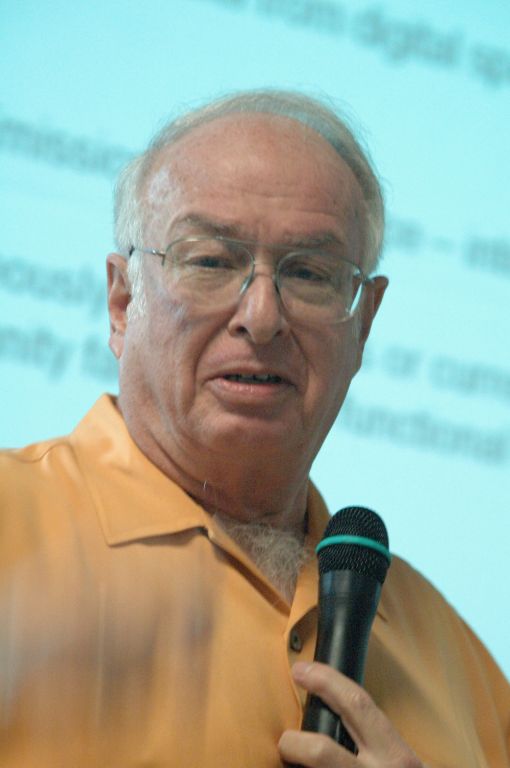2008 Meetings
The linked titles of some meetings are the presentations speakers provided.
December 9, 2008: "WiMAX and White Spaces: What the EMC Engineer Needs to Know for 2009 and Beyond" by Tom Cokenias, TNC Consultants
Abstract: The WiMAX standard for radio transmission has been in development for almost ten years, and is now beginning to get significant traction.
There has been an exponential increase in the number of products and types of service available for WiMAX products this past year, and these products are being targeted to compete with WiFi for services and consumer dollars. Traditional base stations and subscriber units are being augmented by WiMAX products in handsets and laptops, which will eventually make them a ubiquitous concern for EMC in the way that cellular telephones have become.
In February 2009 all analog TV stations in the United States will convert to digital. Several prime frequency bands will be vacated, the so called White Spaces between the digital TV allocations, and recent FCC rule making has allowed unlicensed devices to operate in these bands under new Part 15 regulations. The frequencies extend from low VHF to UHF channels, and devices operating under the new rules are expected to be developed at a rapid rate, given the high penetration and low path losses possible for networks that will use these products. Again, it is expected that these white space devices will be everywhere WiFi is now, and so will require new scrutiny from the EMC community.
The presentation will go over the basic WiMAX modulations, frequency allocations in the US, and the types of products offered currently and in the near future. The new White Space rule making will be discussed, including implications for overall EMC of products that will be used with and near these devices.

Bio: Tom Cokenias is an independent consultant for EMC and Radio Approvals, IEEE member since 1983. After spending 8 years at the FCC Laboratory in Columbia, MD, he moved to the SF Bay Area and worked in senior engineering positions for several local EMC Laboratories. He has served the Silicon Valley EMC Society Chapter in several capacities, including chairman. He can be reached at tom@tncokenias.org
November 11, 2008: "Lightning Testing for Aircraft Electronics" by Michael Hopkins, Hopkins Technical
Abstract: The use of composite materials in new aircraft designs has driven the need for additional testing by manufacturers who supply electronic systems and sub-systems (avionics) to Boeing, Airbus, Bombardier and other aircraft companies. Although aircraft manufacturers have their own test standards, these requirements are generally based on and supplemental to the requirements of DO-160F published by the RTCA (Radio Technical Commission for Aeronautics). The reasons composite materials pose additional problems for the lightning protection of aircraft systems will be discussed, as well as some of the test methods used to minimize the likelihood of lightning causing upset or damage to avionics.
We'll also take a brief look at how the aircraft industry lightning testing compares to lightning testing done in other industries such as Telecom, consumer products and process control. Key similarities and differences exist which might influence future standards development.
Finally, a brief look at the future inclusion of DO-160F in Mil Standards, the next revision of DO-160F, and the development of a users guide.

Bio: Michael has nearly 30 years experience in EMC as an independent consultant and as an employee of Thermo Fisher Scientific working with the KeyTek product lines. He has worked closely with manufacturers and laboratories world-wide providing training, applications help, and assistance with the development of interpretation of test standards. He is the author of several papers and articles on Pulsed EMI phenomena, and has participated in numerous national and international seminars as author, speaker, and panelist. Michael is an active member of several committees developing standards for industry including the ESD Association, IEC Technical Committees 77A and B for the development and maintenance of Basic EMC Standards (US Delegate to Maintenance Team 12 for all pulsed phenomena), IEEE/ANSI, SAE, and RTCA.
October 14, 2008: "Studying embedded capacitance in a practical high-speed PCB design" by Prof. Jun Fan, Missouri University of Science and Technology
Abstract: Ultra-thin power and ground plane pairs (embedded capacitance layers) present superior electrical performance in terms of charge delivery for logic transitions as well as noise mitigation. This presentation will introduce a project of studying the embedded capacitance materials in a high-speed switch board design. Both performance and cost analysis will be discussed.
Bio: Dr. Jun Fan received his B.S. and M.S. degrees in Electrical Engineering from Tsinghua University, Beijing, China, in 1994 and 1997, respectively. He received his Ph.D. degree in Electrical Engineering from the University of Missouri-Rolla in 2000. He is currently an Assistant Professor at the University of Missouri-Rolla. In his previous life, he worked for NCR Corporation, San Diego, CA, as a Consultant Engineer from 2000 to 2007. His research interests include signal integrity and EMI designs in high-speed digital systems, dc power-bus modeling, PCB noise reduction, differential signaling, and cable/connector designs. Dr. Fan received the Conference Best Paper Award from the Applied Computational Electromagnetics Society in 2000. He serves as Chair of the TC-9 Computational Electromagnetics Committee of the IEEE EMC Society.
September 9, 2008: "Presentation by the winner of IEEE Region 6 Central Area MicroMouse Contest 2008" by UC-Davis IEEE Student Branch MicroMouse Team: Josephine Sabado, Laura Biggs, Michael Miller, Mark Tuk and Harpreet Kaur
Abstract: The presentation will focus on what the MicroMouse contest is and how the UC Davis team went about winning the contest. Issues include design decisions, group dynamics, and overall direction taken.
The team designed the MicroMouse from scratch. We researched what type of microcontroller, motors, sensors, tires, and chassis material to use. The professor for the class, Dr. Tak Auyeung, offered suggestions on designing the mouse, time management, and team organization.
The initial task of choosing which materials to use for the MicroMouse was a team effort. Once the components were chosen, each member took on a portion of the mouse. PCB design, chassis design, high-level software, and low-level software were divided among the members according to our strengths and interests. Each team member provided assistance in the other areas as needed.
Throughout the year, Professor Tak emphasized the importance of reliability of the mouse. With this in mind, we made our error correction algorithm the highest priority. Once this worked properly, we were able to improve the speed, chassis design, and appearance of the MicroMouse. Throughout the design and manufacturing process, Professor Tak has provided us with his experiences with MicroMouse and offered suggestions as to how we can improve our design.
Bio:
Josephine Sabado
Josephine is originally from Pomona, CA in Los Angeles County. She graduated from UC Davis this past June
with a bachelor's of science in electrical engineering and a minor in technology management. After working
for a few years, she plans to obtain a master's degree in electrical engineering. She enjoys spending time
with friends while having a good meal at a restaurant.
Michael Miller
Michael graduated from Bella Vista High School in 1998 and entered active duty with the United States Marine
Corps later that same year. After four years of services as a telephone switchboard technician he ended his
service. In the fall of 2003 he started studying at American River College and transferred to UC Davis in
the fall of 2006 with an associates degree in Physical Science/Mathematics. He plans to obtain his
bachelor's degree in computer engineering at the end of the 2008/2009 school year. His interests include
computer programming and platform development.
April 8, 2008: "Unintended Antenna Behavior of Devices and Systems" by Colin Brench
Abstract: This presentation will look at product emission control, considering the numerous antenna effects that are present. A device may be shielded or suppressed at the source, but any radiated emissions that do occur are from an 'antenna' of some sort. A great deal of frustration can result from ignoring this simple fact, as fixes that seem reasonable and that should work, simply don't.
With the high data rates in use today even small structures can be effective antennas. The impact of how a device is mounted into a chassis or how a chassis is mounted into a rack can be unexpected. In this presentation, very small device considerations will be discussed up though full sized racks of systems.
This presentation also includes product measurements that show these effects directly, computer simulations that were used to first identify and then begin to bound the problem for designers. Animations of field propagation will be used to help visualize how the RF energy travels and radiated. Important details such as the addition of ferrite core filter on a cable and cable shield bonding will also be shown.
To show that these effects are pervasive, a concluding section will look at some very common antennas and how they do not always operate as 'intended'.
Bio: Colin is a staff engineer for the Southwest Research Institute (SwRI) in the Electromagnetic Compatibility Research and Testing group. In this position Colin's responsibilities include developing new EMC technologies, providing consulting services, participating in internal and external research programs, and collaborating with the EMC community at large. Prior to SwRI, Colin spent 22 years at HP (Compaq/Digital).
Colin has been active in the area of antenna and shielding behavior since the early 1970's. He has authored over 20 technical papers and articles and holds eleven patents for various methods of EMI control; others are in process. Colin is a co-author of the book, EMI/EMC Computational Modeling Handbook (Kluwer Academic, 2nd Edition 2001), and in 2002 Colin received the IEEE EMC Society Certificate of Technical Achievement for his contributions to the development of EMC models directed to understanding EMI shielding and antenna behavior.
In addition to his technical papers, Colin has presented numerous workshop sessions and training classes on EMC and signal integrity. These embrace a broad range of topics ranging from microprocessor packaging, through printed circuit module issues, to system design and shielding. In many of these classes, explanations are clarified with a combination of simulations and data from measurements. He is a NARTE certified EMC Engineer, a member of the dB Society, a senior member of the IEEE EMC Society, and is serving his second term on the Society's Board of Directors. He is vice chairman of the IEEE EMCS Standards Development Committee and active in the IEEE EMCS TC-9 and ANSI accredited C63 committees. Colin also served a term as a Distinguished Lecturer for the IEEE EMC Society in 2001 and 2002.
March 11, 2008: "Minimizing EMI & Noise - Coupling Among Circuit Regions In Circuit Boards" by W. Michael King
Abstract: Increasingly, circuit boards have a diversity of circuit "block" regions that are not necessarily functionally compatible for noise from region to region in terms of performance margins. High speed "digital circuit regions" will demand high impulse currents from power planes that produce EMI and potentially high "noise" when compared to the sensitivities of "analog regions". Some of this coupling can transfer back and forth due to electromagnetic field currents transferred across chassis! This presentation will cover layout topology concepts in not just the X & Y axes, but the Z-axis as well where coupling "through" chassis is one consideration of the Z-Axis!
W. Michael King has been in the system design, integration, and EMC disciplines for over 47 years, and has consulted most of the major technology corporations in the world. The presentation includes information on the formation of layout topology concepts, separations of planes in the Z-Axis, and the role of copper weight to separate coupling from one circuit board region to another.

Bio: W. Michael King is a systems design advisor with a career spanning over four decades. He has been: engaged in the definition, design, evaluation, implementation, management and execution of well over (an estimated) one thousand projects and systems. He has held positions that have spanned the range from Systems Engineer to Director of Systems Engineering, and Chief Electronics Engineer. He has served as an advisor to Executive Management (Government Agencies and Commercial corporations). His initial period in engineering was in programs allocated broadly to approximately 400 government communications, surveillance, counter-ops (ELINT), and military projects (both AD and Deployment phases). These projects spanned "sensitive" applications and technologies across the frequency range from sub-hertz to tens of gigahertz with system amplitudes ranging from minus 140 dbm to energy in megajoules. Many terms used for PC Board Layout, such as the "3-W Rule", the "V-plane Undercut Rule", and "ground stitching nulls", were all originated by Mr. King. He is generally recognized for his work in Systems Integration, EMC Emission and Susceptibility Control for all forms of systems, and occasionally serves as a manager or systems integrator. He has collaborated on the formations of many networks and standard practices, including the study group for 10/100BASEt. He serves an international client base as an independent design advisor.
Mr. King's published original research changed the state the art on the subjects of the ESD dynamic waveform continuum and responses of cardiac pacemakers to electromagnetic fields. He has authored contributing feature articles to EDN Magazine, Design News Magazine, University of Oxford (England) CPD Newsletter, and Elliott Laboratories Compliance Advisory Service Newsletters as well as other publications.
Significantly, he is the author of EMCT: High Speed Design Tutorial (ISBN 0-7381-3340-X), which is the source of some of the graphics used in his IPC presentation. EMCT provides over 1,200 screens of instruction and is available through Elliott Laboratories, co-branded with the IEEE Standards Information Network.
Services currently provided by Mr. King include: a) performing as a member or lead of project teams to conceptualize the packaging, design, layout, integration and interface schemes of products and systems for appropriate EMC control; b) performing as a member or lead of the program development team to conceptualize or develop the product or system; c) functioning as an advisor to company/product management in order to establish appropriate systems integration policies; d) working with corporate/product management to form organizational efficiency; and, e) acting as an intermediary to coordinate efforts among corporations or groups associated in joint efforts.
February 12, 2008: "Using a Spatial View to Understand and Solve Common Power Bypass Problems" by Steve Weir
Abstract: An ideal power delivery system exhibits a flat impedance at a low enough value across the load frequency. In practice this is not practical as ICs routinely depend on a specific minimum real power supply impedance, interconnects make the power distribution system appear inductive at relatively low frequencies. Analysis of the power system from a spatial standpoint affords both an intuitive and analytically correct view that leads to effective designs at low cost.
Bio: Steve is an independent consultant with over 20 years plus industry experience with a broad range of expertise. Steve holds 17 US patents, and is a consultant with Teraspeed and to X2Y Attenuators. Steve has architected a number of TDM and packet based switching products, consults on patents and is a frequent contributor to the SI-list signal integrity reflector.
January 8, 2008: "License-Free Wireless ISPs (WISPs) and the challenges of FCC Part 15 certification" by Jack Unger
Abstract: The FCC mandates that Part 15 license-free wireless equipment be tested and FCC certified yet many wireless ISPs (WISPs) assemble at least some of their equipment in-house. Join us on January 8th when Jack Unger, President of Ask-Wi.com, Inc. and member of the Wireless ISP Association (WISPA) Board of Directors will present an overview of the wireless ISP industry and describe the Part 15 certification challenges faced by a significant segment of this industry.
Bio: Since 1993 Jack Unger has served as founder and President of Ask-Wi.Com, Inc. (formerly Wireless InfoNet, Inc.) a broadband wireless wide-area networking company. The company has served over 2500 client companies, providing network design, installation, training, consulting and on-site technical support. Since 2001 Mr. Unger has personally trained over 2000 ISP personnel to design, deploy and support outdoor license-free broadband wireless networks. In 2003 he authored the vendor-neutral industry handbook, Deploying License-Free Wireless Wide-Area Networks, published by Cisco Press. Jack has presented wireless training seminars and presentations at many industry conventions, trade shows and wireless user groups including Interop, ISPCON, WISPCON, Wi-Fi Planet, Broadband Wireless World, the National Summit for Community Wireless Networks, the Muni Wireless Conference and the Southern California, Orange County, and San Gabriel Valley Wireless Users Groups. Prior to founding Ask-Wi.Com in 1993, Mr. Unger spent twenty-one years working in the Silicon Valley telecommunications industry including fourteen years with ROLM, IBM, Siemens, and NEC and seven years selling wireless equipment including television and radio station broadcast equipment. Jack has a BA degree in Psychology, AS degree in Electronics and has completed coursework in the UC Berkeley Extension Telecommunications Engineering Program. He holds FCC Amateur Extra class and FCC Commercial Radiotelephone licenses as well as an FAA Private Pilot license. He served for 11 years as a volunteer Firefighter and Emergency Medical Technician in Santa Cruz County and served during four of those years on the Board of Directors of the Zayante Fire Protection District. He currently serves on the Boards of the Santa Susana Mountain Park Association and the Wireless Internet Service Providers Association WISPA) as well as serving on WISPA's FCC and Certification Committees.